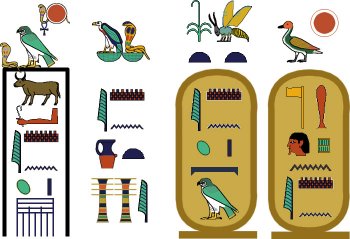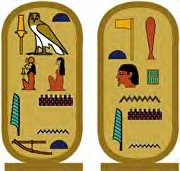



|
I was most eager to see what my friend had drawn for the titles of His Majesty, Tjeti, because His Majesty is a new King who has not yet chosen his names and because names can be written in different ways. He unfurled his scroll on the table in front of me. I bid him explain his choices. "Gebi," the man explained, "I've made up a set of four for His Majesty, Tjeti, and two for Her Majesty, Sekhmet. Ladies first..." As he is an amusing man and fond of the ladies, I humored him and allowed him to put the Queen ahead of our living god.
He caught my smile and with one of his own, continued, "The first cartouche contains the name Sekhmet Meritamen. You will note, no doubt, that the Amen part of meritamen appears ahead of the Merit part: this is 'honorific transposition,' which is what one does when a word contains the name of a deity." I nodded my head sadly and agreed with my friend saying, "Whatever are things coming to in this day and age. Modernizations, I suppose are enivatable."
He quite agreed and after emitting a sigh, continued his explanation. "My reading of the Nisut, Tjeti, is that he is a man who would rather more incline to the imagery of stability and endurance as afforded by the djed, than he would to the image of bondage and femininity, as afforded by the tethering rope and the "bread-loaf t." If you disagree, or should he wish to have it changed when you reveal it to His Majesty, I'll be more than content to change that. Indeed,if either His Majesty Tjeti or Queen Sekhmet require any changes, I shall happily make them." I was delighted with the fine job that my friend had done and insisted that he and his friends stay for a night of entertainment and a delicious meal at my villa. His Majesty has only recently come to the throne of Kemet and so has not chosen his names and how they will be represented. I feel very confident that he will approve of what I show him. |
| More Info Page | About the Cartouches | History and Bios | Links | Time in Egypt | Credits |